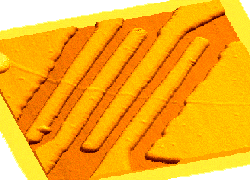Splitting Up Cooper Pairs
Entangled pairs of particles, in which measuring the state of one simultaneously determines the state of the other, are a central part of proposed schemes for quantum cryptography and teleportation. One potential source of such particles is the stream of conjoined electrons that exist in superconductors, but no one has been able to drive a wedge between these so-called Cooper pairs. A proposal in the 15 July print issue of PRL suggests one possible separation method: send them down a pair of carbon nanotubes. Experimenters may have the technology needed for such an experiment in a few years.
The crazy thing about entanglement is that it allows you to learn the state of a distant particle simply by doing a measurement on its nearby partner. The trick is finding a reliable source of entangled particles. Cooper pairs, which exist naturally in an entangled state, are an obvious choice. The usual way of separating a pair from the pack is to force it to tunnel across an insulating barrier, but getting the electrons to tunnel into a pair of metallic leads won’t break the pairs apart. The electronic structure of carbon nanotubes–sheets of pure carbon rolled into thin, micron-long cylinders–offers just the right incentive for Cooper pairs to split, according to Smitha Vishveshwara and coworkers at the University of California, Santa Barbara (UCSB). Electrons in the tube interact strongly with one another, and they effectively live in one dimension. These conditions lead to a Luttinger liquid, which is capable of violating Ohm’s law and displaying other unusual properties.
One of these properties is key to the researchers’ scheme. Adding an electron to a nanotube requires all the others to completely rearrange. But adding two electrons creates much more than twice the strain that adding just one creates. So a Cooper pair should split up rather than stay together when confronted with a matching pair of nanotubes and a voltage drop to get the electrons moving into the tubes.
Entangled pairs could conceivably travel a relatively far distance in nanotubes. “We’re not talking about a few Angstroms–we’re talking about microns,” Vishveshwara says. They would remain quantum mechanically pure because their spin states would be entangled, and the spins of electrons and carbon atoms in a nanotube don’t generally interact. Eventually researchers might be able to construct whole arrays of nanotubes capable of transporting entangled particles greater distances or even coupling them, she says, possibly serving as components for quantum computers or message relays.
The applications are not the important point, says Charles Marcus of Harvard University. Rather, simply being able to study entanglement in the solid state would be novel, and could lead to new theoretical understanding or unforeseen applications. As for actually doing the experiment, “I don’t think it’s unrealistic physically, but these are really hard experiments,” says Marcus. David Awschalom of UCSB says the experimental setup is reasonable, but getting direct measurements of entangled electrons’ spin states could require devices that may not be ready, even as prototypes, for at least a year or two.
–JR Minkel
JR Minkel is a freelance science writer in New York City.



